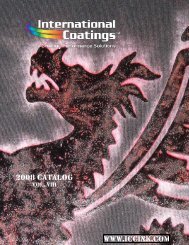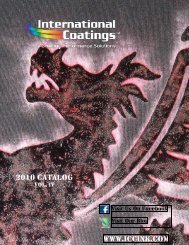2008 CATALOG WWW.ICCINK.COM
2008 CATALOG WWW.ICCINK.COM
2008 CATALOG WWW.ICCINK.COM
Create successful ePaper yourself
Turn your PDF publications into a flip-book with our unique Google optimized e-Paper software.
INTERNATIONAL COATINGS TRANSFER PRODUCTS<br />
screen with water and a cleaner such as Formula 409 after use. Once the adhesive has set up, (dried) in the screen, it<br />
is very difficult to remove.<br />
NOTE:<br />
NYLON TRANSFERS<br />
Nylon transfers are made using International Coatings 900 series inks, not catalyzed, # 210 solvent based<br />
adhesive and 290T heat resistant silicone paper. The 900 Series inks are printed through a 110 to 125 monofilament<br />
screen mesh and completely fused, 325°F to 375°F (163°C to 191°C) on the 290T paper. The ink has to be<br />
completely fused so that the ink is resistant to the solvent in the 210 adhesive. The 210 adhesive is then printed over<br />
the 900 ink. The adhesive must overlap the entire printed ink film by at least 1/32". It is the 210 adhesive that<br />
bonds the ink to the nylon, so it must cover the whole ink film, including a little outside the edges of the design. The<br />
210 adhesive should be printed through a 61-monofilament screen mesh coated with a solvent resistant emulsion.<br />
Use a 65 to 80 durometer squeegee. Completely fuse the adhesive at the same temperatures as the ink. The colors<br />
may overlap each other as in a cold peel transfer and are dried between each color. The 290T paper is necessary for<br />
proper performance of the transfer. It has an excellent release and will not break down from the high heat needed to<br />
make nylon transfers. Use International Coatings # 275 thinner for cleaning and thinning the 210 adhesive. To<br />
wash up the 900 inks, use mineral spirits or plastisol screen wash.<br />
NOTE:<br />
For greater durability of the foil after it is applied, it is recommended that the garment be hand<br />
washed or machined washed (delicate cycle) inside out and line or air-dried.<br />
Use proper precautions and adequate ventilation when using the 210 adhesive and 275 thinner.<br />
When heat sealing finished transfers to nylon, it is recommended that the fabric be preheated for 5 seconds<br />
at 325°F to 375°F (163°C to 191°C) to remove surface moisture and wrinkles. Try lower application temperatures<br />
for best results (325°F to 350°F). Place transfer in position and heat seal for 10 to 15 seconds at 325°F to 375°F<br />
(163°C to 191°C). Application temperature depends on stability of nylon to heat. After heat sealing and before<br />
removing transfer, immediately rub the hot transfer with a cloth to eliminate bubbling. Be careful not to rub too<br />
hard or the transfer may move before cooling. Remove transfer when cool. An edge of adhesive may show around<br />
applied nylon transfer on darker fabrics. Suitable tests must be conducted to determine suitability of transfers for<br />
nylon applications.<br />
RE<strong>COM</strong>MENDATIONS AND STATEMENTS MADE ARE BASED ON INTERNATIONAL COATINGS RESEARCH AND EXPERIENCE. SINCE<br />
INTERNATIONAL COATINGS DOES NOT HAVE ANY CONTROL OVER THE CONDITIONS OF USE OR STORAGE OF THE PRODUCT SOLD,<br />
INTERNATIONAL COATINGS CANNOT GUARANTEE THE RESULTS OBTAINED THROUGH USE OF ITS PRODUCTS. ALL PRODUCTS ARE SOLD<br />
AND SAMPLES GIVEN WITHOUT ANY REPRESENTATIONS OF WARRANTY, EXPRESSED OR IMPLIED, OF FITNESS FOR ANY PARTICULAR<br />
PURPOSE OR OTHERWISE, AND UPON THE CONDITION THAT THE BUYER SHALL DETERMINE THE SUITABILITY OF THE PRODUCT FOR ITS<br />
OWN PURPOSE. THIS APPLIES ALSO WHERE RIGHTS OF THIRD PARTIES ARE INVOLVED. IT DOES NOT RELEASE THE USER FROM THE<br />
OBLIGATION TO TEST THE SUITABILITY OF THE PRODUCT FOR THE INTENDED PURPOSE AND APPLICATION. REV70100<br />
4<br />
123




